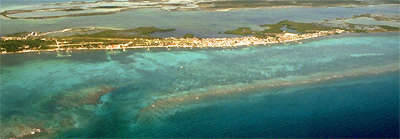|
| Reef Zones: Ecosystems that are Inseparably Connected
About a kilometer from the shore exists a visible line of breaking waves, denoting a rich area of coral growth. A region of clear, transparent water leads up to this surf line and beyond this line the water quickly turns to a deep royal blue. The change in the appearance of the sea is due to the dynamic landscape beneath the water, and the way light is reflected from the sand. Like a miniature mountain system, coral reefs are made up of peaks and valleys; reefs are not uniform, but are formed by the wave action of the sea and the structure of the sea floor. This has created a series of different sections or reef zones, each with distinct features and populations of organisms. The three primary reef zones are the lagoon (beach, mangrove, seagrass beds, patch reefs), the reef crest, and the fore reef.
As the bottom of the lagoon rises rapidly toward the waters surface, the next zone, the reef crest, begins. This zone is characterized by a line of waves that break along its edge, with low tides further exposing sections of the reef. The first scattered coral heads appear here and increase gradually along the crest. In the rear of this zone, there are varied coral populations, predominantly shallow-water species such as Boulder Coral, Brain Coral, Staghorn Coral, and Elkhorn Coral. Because storms crash against it and break off coral fragments, fewer species of corals often exist in this zone. Still the reef crest does provide a habitat for many plants and animals, such anemones, sponges, and approximately 400 species of fish. On the seaward edge of the reef is the final zone, the fore reef, divided into an upper and lower section. Due to a high exposure to sunlight, the upper section is very productive and home to a diversity of reef life, such as hard and soft corals, sponges, lobster, clams, fish, and sea turtles. In this section, gentle slopes extending from 10 ft to 70 ft in depth are apparent. As the fore reef begins to drop off, the lower section begins. With increased depth, many coral species change in shape and various species of hard corals that are uncommon in shallow water become very abundant. All of the aforementioned zones are inherently connected and dependent on each other. The mangroves and seagrass beds act to trap sediments that might otherwise settle and block sunlight to the reef. Furthermore, they serve as habitat and provide nutrients for reef life. In return, the coral reef protects the beach, mangroves, and seagrass beds from erosion due to waves. Thus, when any one of these elements is adversely affected, the ecosystem as a whole is impacted. This Reef Brief was written by Ann Hayden. For more information and charts about this area, see the Field Guide to Ambergris Caye.
|
 Copyright by Casado Internet Group, Belize |
 The lagoon lies between the beach and the reef crest. This shallow, protected area is home to a diverse group of plant and animal life. Mangroves, plants found in the transitional area between land and water, protect the coastline by trapping sediments and also serve as an important habitat for various species of animals. The lagoon also includes seagrass beds, which provide animals with a rich source of food and protected habitat. In some cases, lagoons contain flat, circular islands of coral surrounded by seagrass and sand, known as patch reefs. As with mangroves and seagrass beds, the diversity of marine life around the patch reefs is immense and includes such species as sea turtles, sea cucumbers, and conch.
The lagoon lies between the beach and the reef crest. This shallow, protected area is home to a diverse group of plant and animal life. Mangroves, plants found in the transitional area between land and water, protect the coastline by trapping sediments and also serve as an important habitat for various species of animals. The lagoon also includes seagrass beds, which provide animals with a rich source of food and protected habitat. In some cases, lagoons contain flat, circular islands of coral surrounded by seagrass and sand, known as patch reefs. As with mangroves and seagrass beds, the diversity of marine life around the patch reefs is immense and includes such species as sea turtles, sea cucumbers, and conch.